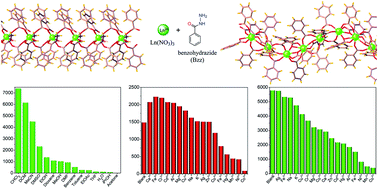The coordination chemistry of benzhydrazide with lanthanide(iii) ions: hydrothermal in situ ligand formation, structures, magnetic and photoluminescence sensing properties†
Abstract
The influence of synthetic conditions on the solid-state structural formation of lanthanide(III) complexes based on a hydrazide ligand have been investigated and reported. Depending on the solvents and reaction temperatures, the reactions of hydrated Ln(NO3)3 with a benzohydrazide (bzz) ligand afforded three classes of lanthanide(III) coordination complexes viz. [Ln(bzz)(NO3)](NO3)2 (1Ln; Ln = Sm (1), Eu (2), Gd (3), Tb (4), Dy (5)), [Ln(bzz)(ben)3(H2O)]·H2O (2Ln; Ln = Pr (6), Nd (7), Sm (8), Eu (9), Gd (10), Tb (11), Dy (12), Er (13)), and [Ln3(ben)3] (3Ln; Ln = Eu (14), Gd (15), Tb (16), Dy (17), Er (18), Tm (19), Yb (20), Lu (21)). Complexes 1–5 in series 1Ln were isolated by slow evaporation of their isopropanol solutions at ambient temperature, and the complexes display similar discrete structures bearing distinct intermolecular N–H⋯O hydrogen bonds to generate a three-dimensional (3D) supramolecular architecture. Complexes 6–13 in series 2Ln were obtained under hydrothermal conditions at 110 °C where the in situ generated benzoate (ben) ligands participated in the formation of one-dimensional (1D) coordination polymers (CPs) with the bzz ligands. At a temperature of 145 °C the hydrothermal conditions result in the formation of the thermodynamically more stable products of 14–21 in series 3Ln, in which the bzz ligand underwent complete in situ hydrolysis to create the ben ligand. These coordination assemblies feature 1D zigzag chains that are formed by unusual low coordination numbers of the six- and seven-fold coordinated Ln3+ centers bridged by the ben ligands in μ2- and μ3-coordination modes. Notably, the chain structures of 2Ln can be transformed into the zigzag tape-like structures of 3Ln upon heating the crystalline samples to 400 °C in air. In the solid state at room temperature, the Eu- (2, 9, 14) and Tb- (4, 11, 16) containing complexes emit red and green light, respectively. The luminescence investigations show that the Eu- (9, 14) and Tb-(11, 16) based CPs could be used as fluorescent probes for acetone and Co2+ ions via an energy competition mechanism. Meanwhile, the Gd- (10, 15) and Dy- (12, 17) based CPs show typical antiferromagnetic interactions.



 Please wait while we load your content...
Please wait while we load your content...